Fly Fishing with Doug Macnair: Product Update: Cortland’s 444SL Precision Tapers
Fly Fishing with Doug Macnair: Product Update: Cortland’s 444SL Precision Tapers
By Doug Macnair
As a follow on to the review of Cortland’s superb Sylk fly line, this review of the 444SL Precision Taper continues the discussion of Cortland’s most recent innovations in fly line design... Also included free, at no cost to you, is a little more nostalgia from that time long ago when reels were reels and men were fly fishers. 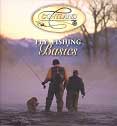 Take another look at the title of this article. Does the term, WF-5.5-F catch your eye? It should … You are looking at the first line that purports to be a half-step between the standard 5 and 6-weight lines you and I have known for years. Is this a significant development? Absolutely! Take another look at the title of this article. Does the term, WF-5.5-F catch your eye? It should … You are looking at the first line that purports to be a half-step between the standard 5 and 6-weight lines you and I have known for years. Is this a significant development? Absolutely! For those of you who have not read my on-line manuscript, Fly Fishing for the Rest of UsÓ, it’s worth noting that I consider the combination of fly line and line weight to be to the two most critical aspects of the sport -- certainly more important than the fly rod or fly reel. It’s important to understand that the weight of a fly line is the only standard in fly fishing. In days long gone by, chaos reined when it came to describing a line that accurately fitted this or that fly rod. The fact is no standard existed for anything in the fly fishing industry, much less fly lines. Consequently, most folks operated on different wave-lengths because fly lines were still being made several ways. Then one day, the folks in AFTMA (the American Fishing Tackle Manufacturers Association) got together and standardized line weights. This was then, and remains today, a big deal -- for the first time fly fishers had a constant between themselves, makers, and manufacturers. 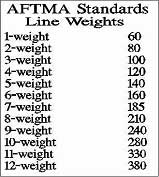 Here's how the AFTMA standards work: Lines are rated by the weight in grains contained in the first 30-feet of the line. Why 30 feet? It was agreed that 30-feet represented a reasonable length of line required to initially load the rod during the backcast. The chart to the right reflects the weights adopted by AFTMA. The important thing to remember is that these weights apply to only the first 30-feet of fly line. To this day, no other standard exists in the fly fishing industry. Everything else – rod, reel, backing, and/or the remainder of the line – is left to the eyes of the beholder. Here's how the AFTMA standards work: Lines are rated by the weight in grains contained in the first 30-feet of the line. Why 30 feet? It was agreed that 30-feet represented a reasonable length of line required to initially load the rod during the backcast. The chart to the right reflects the weights adopted by AFTMA. The important thing to remember is that these weights apply to only the first 30-feet of fly line. To this day, no other standard exists in the fly fishing industry. Everything else – rod, reel, backing, and/or the remainder of the line – is left to the eyes of the beholder. Unfortunately, there are variables in the manufacturing process that prohibit meeting these ideals. There is apt to be some variance, batch to batch, of a given line. Mixing the ingredients of core and coating as well as the designer’s taper is precise – but not perfectly so. It just doesn’t happen that way … So, the AFTMA standards allow for an acceptable weight range for each line weight as reflected in this depiction. This range in line weights is important to our discussion. 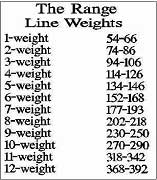 Depending on the particular batch of lines, it’s quite possible that any 5-weight line you buy is not going to weigh AFTMA’s ideal of 140-grains. More than likely it will fall to one side or the other – either a bit heavy or a bit light. Note that a “heavy” 5 is very close to a “light” 6, a difference of only 6-grains. Reverse the situation to a “light” 5 and a “heavy” 6 and the results are a very meaningful 34-grains in weight. This sort of difference can account for some otherwise inexplicable results in the casting abilities of two competent casters armed with similar systems. Add in the fact that there is more than one “expert” who recommends overlining by one weight and what otherwise would seem a simple subject becomes quite complex. Depending on the particular batch of lines, it’s quite possible that any 5-weight line you buy is not going to weigh AFTMA’s ideal of 140-grains. More than likely it will fall to one side or the other – either a bit heavy or a bit light. Note that a “heavy” 5 is very close to a “light” 6, a difference of only 6-grains. Reverse the situation to a “light” 5 and a “heavy” 6 and the results are a very meaningful 34-grains in weight. This sort of difference can account for some otherwise inexplicable results in the casting abilities of two competent casters armed with similar systems. Add in the fact that there is more than one “expert” who recommends overlining by one weight and what otherwise would seem a simple subject becomes quite complex. Now comes the Cortland Precision Taper with its 5.5-weight … and why not? Fly rod actions vary a great deal these days, ranging from very stiff, through those that “bend here but not there,” to those that “bend a whole bunch everywhere.” Throw in the variable of the fly caster and his or her casting stroke and the line matched to the fly caster and rod becomes critical for maximum efficiency. I can see a place for the 5.5 and perhaps two or three more half-step lines. Please understand that I ordinarily advocate staying with the manufacturer’s suggested line recommendations or, in the case of the heavier weights 6-9, underlining by one weight depending on the circumstances. As for the concept of overlining, it might enable a neophyte to feel the rod load, but other than that it’s a great way to sell replacement fly rods. Is there a bottom line to the importance of line weight? You bet! It’s in the amount of line you aerialize in making the cast. Consider for a moment that while you and I now know the weight in grains for the first 30-feet of our line, we don’t know the weight of the remainder that typically includes the rest of the head, its rear taper, and the running line … An interesting thought? It should be, because for every ten to fifteen feet we add to the initial 30 hanging in the air, we effectively add another line weight to the load carried by the rod. Said another way: a 5-weight line becomes the equivalent of a 6-weight when 40-feet of line are aerialized, a 7-weight with 60 to 65-feet in the air, etc. At some point, of course, our 5-weight rod will overload resulting in either a collapsed cast or worse, a broken rod … When that happens, The Ancient Fish Gods laugh and laugh. When the time came to load the 444SL WF-5.5-F to a reel, a wave of nostalgia led me to select a rather old Shakespeare Speedex. Made in England years ago, the Speedex is a multiplier. Applied to this reel, the term, multiplier, simply means that a full single turn of the handle during the retrieve doubles the line retrieved (2:1 ratio) in contrast to the line retrieved by the ordinary 1:1 ratio found on most reels of today. 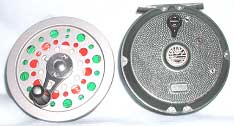 Why use the Speedex? Easy! I wanted to strike back against today’s “large arbor” fad. My Speedex recovers line just as fast, if not faster, than one of those popularized large hulks. And I hasten to add that with its narrow spool, recovering line is a simple task, and laying it to the spool even simpler compared to one of those wide-mouth large arbor monsters. Like almost anything else in world, for every action there is a reaction… Why use the Speedex? Easy! I wanted to strike back against today’s “large arbor” fad. My Speedex recovers line just as fast, if not faster, than one of those popularized large hulks. And I hasten to add that with its narrow spool, recovering line is a simple task, and laying it to the spool even simpler compared to one of those wide-mouth large arbor monsters. Like almost anything else in world, for every action there is a reaction… The Speedex is/was similar in construction to the old Pflueger Medalist except the frame standoffs were riveted as opposed to being screwed together. More importantly, the exposed spool enables palming, increasing the drag capabilities that otherwise are left to the clicker. Is it a good reel? You bet! While the guts of the reel used fabrics (the exact formulation I know not) they wear well with age, given nothing more than ordinary care. As you wander around antique stores and the many flea markets that abound, keep your eyes out for a Speedex Multiplier. I predict the multiplier with return to the fly fishing scene … For most situations, it seems a far better solution to line recovery than the large arbor reel. Of course, when it does return, the multiplier will be hyped as the greatest step forward in fly fishing since the stick and vine. (You and I, of course, will know that’s crapolla -- even as we rush out to buy one…) My Speedex fell in love with the 5.5. Together, the two performed beautifully depending on the rods to which they were attached … and there were many. Because of the unique half-step of Cortland’s 5.5 in the AFTMA standards, I ran up and down the scale during this review using rods with weights ranging from 4 through 7, according to the manufacturer’s label. 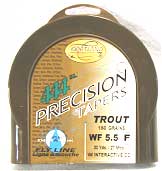 The Precision Tapers of the 444SL series, according to Cortland, is designed to assure a smooth turnover of the fly. Driven by the diversity in rod actions and weight rating - always a variable - Cortland suggests that the half-steps in line weights will enable the fly fisher to more perfectly match his or her casting stroke and fly rod to their fishing environment. My experience suggests that Cortland is on the right track. None of my 4-weights liked the 5.5 other than for close-in work; all of my 5-weights cast the line without difficulty – one, a particularly fast rod, took a liking to the 5.5 and tossed very long lines. Of the batch of 6-weights, one took to the 5.5 as if they were made for each other. It threw the best of the entire group. No question that a 7-weight will also throw the 5.5, but not as a preferred diet. The Precision Tapers of the 444SL series, according to Cortland, is designed to assure a smooth turnover of the fly. Driven by the diversity in rod actions and weight rating - always a variable - Cortland suggests that the half-steps in line weights will enable the fly fisher to more perfectly match his or her casting stroke and fly rod to their fishing environment. My experience suggests that Cortland is on the right track. None of my 4-weights liked the 5.5 other than for close-in work; all of my 5-weights cast the line without difficulty – one, a particularly fast rod, took a liking to the 5.5 and tossed very long lines. Of the batch of 6-weights, one took to the 5.5 as if they were made for each other. It threw the best of the entire group. No question that a 7-weight will also throw the 5.5, but not as a preferred diet. I was impressed with the results … the difference between 140, 150, and/or 160 grains might not seem a lot, but the effect on the cast - given a specific rod - can be remarkable, especially when the cast is going for distance. There isn’t any question in my mind that the results rest in the sum of the casting stroke, the rod’s action, and the fly line’s characteristics. The 5.5 will give you very precise and easy presentations that all of us strive for. I could not ask for greater accuracy particularly in the 50 to 70-foot range. With the 5.5 Cortland has given us not only a new line but also a line with new features. For example, the 5.5. has a new front taper called the Rocket 2. It’s designed with more weight up front and has an especially long back taper to enhance aerialization. To this, add the slickest line coating yet from Cortland called Duraslick. The outer coating is fully guaranteed for the life of the line. Finally, the 5.5 sports a two-tone color to make it very simple to recognize the maximum load point. Deciding where to lift into the backcast has never been simpler. I just wish all manufacturers would follow suit in this practice. The 444SL Precision Tapers follow-on in the new packaging treatment I complimented in the review of the Sylk. Along with the line, an interactive CD and cleaning pad are all incorporated into a very reusable plastic case. As I said before, it beats the hell out of a cardboard box. For beginners the CD is a very useful tool; for those more advanced, it will assist in determining what line to try next including the specifics of head length, belly, and running line. If you have a very fast 5-weight rod, of some other 5 or 6-weight that seems hard to please, I would be the first to recommend trying the Cortland WF-5.5-F. It may just prove to be the perfect line for you. And Keep in mind that whatever does it best for you is the very best there is! For more information about the 444SL Series, contact: The Cortland Line Company, Inc. 3736 Kellogg Road, P.O. Box 5588, Cortland, NY 13045-5588. 1-(607) 756-2851. To purchase the Cortland 444SL Precision Floating Trout Taper Fly Line, please click here
|
